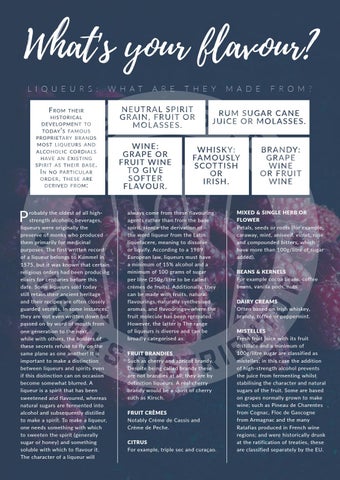SPIRITS
What's your flavour? LIQUEURS & SPECIALITY
L I Q U E U R S :
W H A T
F ro m
their h i s to r i c a l d e v e lo p m e n t to to day ’ s Fa m o u s p ro p r i e ta ry b r a n d s most liqueurs and a lco h o l i c co r d i a l s h av e a n e x i s t i n g s p i r i t a s t h e i r ba s e . i n n o pa rt i cu l a r order, these are d e r i v e d F ro m :
98
T H E Y
N E UT RA L S P IRIT G R A I N, FRU IT OR M OL A S S E S . WINE: G R A PE OR F RUI T W IN E TO GIV E SOF TE R F L AVOU R.
P
robably the oldest of all highstrength alcoholic beverages, liqueurs were originally the preserve of monks who produced them primarily for medicinal purposes. The first written record of a liqueur belongs to Kummel in 1575, but it was known that certain religious orders had been producing elixirs for centuries before this date. Some liqueurs sold today still retain their ancient heritage and their recipes are often closely guarded secrets. In some instances, they are not even written down but passed on by word of mouth from one generation to the next, while with others, the holders of these secrets refuse to fly on the same plane as one another! It is important to make a distinction between liqueurs and spirits even if this distinction can on occasion become somewhat blurred. A liqueur is a spirit that has been sweetened and flavoured, whereas natural sugars are fermented into alcohol and subsequently distilled to make a spirit. To make a liqueur, one needs something with which to sweeten the spirit (generally sugar or honey) and something soluble with which to flavour it. The character of a liqueur will
A R E
INN EXPRESS - DRINKS PORTFOLIO
M A D E
RU M S U GA R CA NE J U ICE OR MOL A S SES.
W H IS K Y: FA MOU S LY S COTTIS H OR IR IS H .
always come from these flavouring agents rather than from the base spirit. Hence the derivation of the word liqueur from the Latin liquefacere, meaning to dissolve or liquify. According to a 1989 European law, liqueurs must have a minimum of 15% alcohol and a minimum of 100 grams of sugar per litre (250g/litre to be called crèmes de fruits). Additionally, they can be made with fruits, natural flavourings, naturally synthesised aromas, and flavourings—where the fruit molecule has been recreated. However, the latter is The range of liqueurs is diverse and can be broadly categorised as: FRUIT BRANDIES Such as cherry and apricot brandy. Despite being called brandy these are not brandies at all; they are by definition liqueurs. A real cherry brandy would be a spirit of cherry such as Kirsch. FRUIT CRÈMES Notably Crème de Cassis and Crème de Peche. CITRUS For example, triple sec and curaçao. - LIQUEURS & SPECIALITY
F R O M ?
BRA N DY: GRA P E W IN E OR FRUIT W IN E
MIXED & SINGLE HERB OR FLOWER Petals, seeds or roots (for example, caraway, mint, aniseed, violet, rose and compounded bitters, which have more than 100g/litre of sugar added). BEANS & KERNELS For example cocoa beans, coffee beans, vanilla pods, nuts. DAIRY CREAMS Often based on Irish whiskey, brandy, toffee or peppermint. MISTELLES Fresh fruit juice with its fruit distillate and a minimum of 100g/litre sugar are classified as mistelles; in this case the addition of high-strength alcohol prevents the juice from fermenting whilst stabilising the character and natural sugars of the fruit. Some are based on grapes normally grown to make wine; such as Pineau de Charentes from Cognac, Floc de Gascogne from Armagnac and the many Ratafias produced in French wine regions; and were historically drunk at the ratification of treaties, these are classified separately by the EU.
